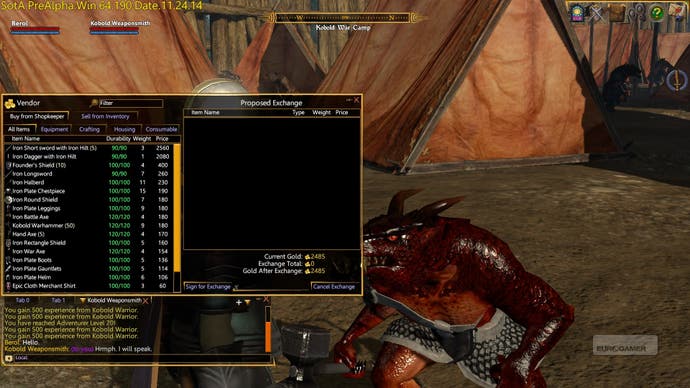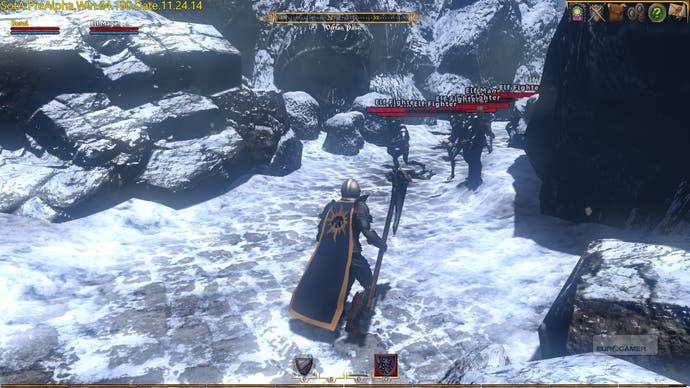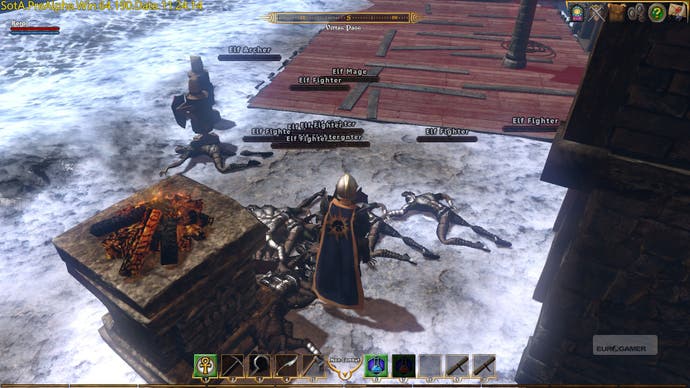Richard Garriott's Shroud of the Avatar is Ultima Online 2 in so many ways
It has promise but the pre-alpha isn't recommended for all.
When Ultima Online came out 17 years ago it blew my teenage mind. My medieval fantasy world was alive, inhabited by actual other people. I didn't care that I didn't have any idea what to do because it was so exciting! But Ultima Online was obtuse - making progress was an initiation, not a right. It was a reward in and of itself. And knowing that someone could come and kill you in a dungeon and loot everything you carried? Part of the magic.

Now massively-multiplayer role-playing games are common, and they've changed (barring ye olde Eve Online). They're friendly, they don't kick you while you're down. They can't; if they let go of your hand and you stray too far off the entertaining path, you'll leave - and they can't afford you to. Attitudes changed and their design changed, but for the better?
Not according to Richard Garriott, creator of Ultima Online, but what does he know? He hasn't made a great game since Ultima Online. For us to listen, he'll have to prove it - prove he knows better by making the game we want him to: Ultima Online 2. After playing his new game Shroud of the Avatar for 15 hours I can tell you that it is the sequel he's threatened, in so many ways.
But let me make this clear: if you don't know Ultima Online, don't play it - yet. Don't pay the £30 Steam Early Access asking price because you'll see a game with dodgy graphics, archaic combat and ugly menus. You'll grind wolves and skeletons like it's 1997, in a game that looks and feels like it's 1997. You won't have any idea where to go, how to craft or what to do, and you'll want your money back. Look again next year, when pre-alpha is long over.
However, if you've been waiting for a Richard Garriott Ultima Online follow-up, then with caution you may proceed, because there's real promise.
Shroud of the Avatar isn't as charming as Ultima Online yet, but it's going for the same look and the same feel. You sign for trades with NPCs, type keywords to prompt NPC reaction and cast (some) spells with reagents - and they can fail, Fizz. The music can be near identical in places and it's lovely, a real reason to listen, although the sound effects are placeholder bad. There's all the player housing surrounding the cities - grandiose abodes and even castles - and the classless skill system, the player-run economy and myriad crafting options and tables. At times you really could be in a 3D version of Ultima Online, only without the elegance of that isometric world.

Ultima Online had a whimsy, a feeling of a dusty old tome: parchment menus, leather bag interiors for backpacks, stony health bars. The interface in Shroud changed from something similar to something ugly and functional for Early Access, and I hope it doesn't stay that way. Characters have a cartoony feel, and the environments are mainly murky and dull. Cities and a day-night cycle sporadically elevate it, but the poor performance besmirches their efforts.
But Shroud of the Avatar also sets out to do things differently. It's not a pure MMO but a "selective multiplayer" game. You can play it offline, alone, ignoring everyone else forever, or you can play it online in a number of ways. You can play Single-Player Online, ignoring everyone else but making use of the shared economy and world; you can play Friends Only online, seeing only your friends; or you can play it in full multiplayer online and see everyone else.
Combat has changed for a deck building system and uses skill trees, neither of which were in Ultima Online. When you level up, you earn Skill Points, and can spend them in whichever tree you like. Doing so unlocks active glyphs (abilities or spells) that you can build a combat deck with. The glyphs you put in the deck appear at random, and temporarily, in your hotbar during combat. Some can be combined to make combos.

Slugs - unusable grey blocks - pop up in your hotbar during combat, uselessly occupying a slot for a while. How many Slugs are in your deck, your heft of armour declares. Then there's an entire skill tree designated to altering how your deck works: size of hotbar, speed of glyph draw, number of glyphs you can lock in place - even the ability to discard a hotbar for a fresh full compliment of glyphs immediately.
Mastering deck building and optimising your build - choosing which equipment, which skills - is an art. Fortunately you can reset and change it as often as you visit a Skill Trainer in town.
It's fortunate because like so much else in Shroud of the Avatar, it's not well explained. It's not even finished being made. If you want to know how to build your character, want to know where to go, it's trial and error and searching the internet for community videos and articles.

There aren't any exclamation marks leading you around the world. There are quests but you'll have to talk to people to find them, and don't expect to be able to immediately complete them when you do. There's no world map blinking objectives at you, or even a town map marking points of interest - there are only scroll maps with the rough layout of the town, and a compass when you're on the top-down world map that links zones.
There's no clear progression path beyond heading to an area with monsters around your level and standing there and killing them - as was the norm in old MMOs. Finally when you've killed enough, you level up, and maybe you've got enough money for some sturdy equipment. Then you try and find a new area to fight in.
It's a boring cycle that MMOs improved upon long ago, and it's made all the more wearisome because combat lacks any heft or punch in Shroud. Certainly don't come from World of Warcraft expecting to be thrilled by the systems here.
So why do it, why play on? Because when I found a way, through perseverance, to level my way up to 25 (from five), by running around in circles so enemies couldn't hit me - I know - I felt like I had achieved something, become somebody. I could feel a newcomer's eyes on me as I walked past. "How did he do that?!" I felt like I'd achieved something precisely because I knew how hard it once seemed. I'd figured it out. It was the same joy I felt in figuring out Ultima Online.

I haven't figured crafting out beyond making a few ingots, though, and there's fathoms of depth there - even whole skill trees (not implemented) for it. Without money or the known location of places to harvest materials, and the power to survive there, you won't get anywhere. And getting anywhere will take time.
Some magic skill trees aren't implemented yet and there's no real incentive to try it, given the relative power of melee and, more importantly, heavy armour. Also, while I tried to find PVP in the Owl's Head arena and on the open PVP island, both were deserted. But I did see people flagged as PVP running around so it's happening somewhere. I still don't know how to turn my PVP flag on just like I don't know how to do so much else in the game.
Shroud of the Avatar, at the moment, is a house with foundations and stud walls but no plaster or decoration. There's a long way to go. But it's a house with a clear design, a cohesive vision behind it, from people who are particular about what they want to create. That house isn't designed for everyone but those who appreciate it will stay a long time, because it's built for them.
Does Shroud of the Avatar prove Richard Garriott knows best? Not yet. But he knows something, and it would be wrong to ignore him.






.png?width=291&height=164&fit=crop&quality=80&format=jpg&auto=webp)



